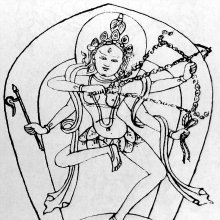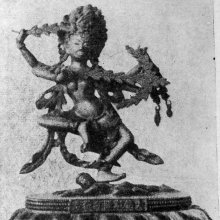Shukla, Śukla, Śuklā, Suklā, Sukla: 34 definitions
Introduction:
Shukla means something in Buddhism, Pali, Hinduism, Sanskrit, Jainism, Prakrit, the history of ancient India, Marathi, Hindi, biology, Tamil. If you want to know the exact meaning, history, etymology or English translation of this term then check out the descriptions on this page. Add your comment or reference to a book if you want to contribute to this summary article.
The Sanskrit terms Śukla and Śuklā can be transliterated into English as Sukla or Shukla, using the IAST transliteration scheme (?).
Alternative spellings of this word include Shukl.
Images (photo gallery)
In Hinduism
Ayurveda (science of life)
Nighantu (Synonyms and Characteristics of Drugs and technical terms)
Source: WorldCat: Rāj nighaṇṭuŚuklā (शुक्ला) is another name for Kākolī, a medicinal plant identified with Roscoea purpurea from the Zingiberaceae or “ginger family” of flowering plants, according to verse 3.25-27 of the 13th-century Raj Nighantu or Rājanighaṇṭu. The third chapter (guḍūcyādi-varga) of this book contains climbers and creepers (vīrudh). Together with the names Śuklā and Kākolī, there are a total of fifteen Sanskrit synonyms identified for this plant.
Toxicology (Study and Treatment of poison)
Source: Shodhganga: Kasyapa Samhita—Text on Visha ChikitsaŚukla (शुक्ल) or “semen” refers to one of the thirteen sources of Jaṅgama (mobile) poison, as described in the Kāśyapa Saṃhitā: an ancient Sanskrit text from the Pāñcarātra tradition dealing with both Tantra and Viṣacikitsā—an important topic from Āyurveda which deals with the study of Toxicology (Viṣavidyā or Sarpavidyā).—Kaśyapa states in the fourth Adhyāya that Śiva taught him that poisons are of five kinds viz. immobile, mobile, artificial, caused by planets and (arising out of) doubt. The sources of these five kinds of viṣa, Kaśyapasaṃhitā deals mainly with the sthāvara (immobile), jaṅgama (mobile) poison according to Kaśyapa are thirteen in number [viz., semen (śukla)].
Unclassified Ayurveda definitions
Source: Wisdom Library: Āyurveda and botany1) Śukla (शुक्ल) is another name (synonym) for Śvetairaṇḍa: one of the three varieties of Eraṇḍa, which is a Sanskrit name representing Ricinus communis (castor-oil-plant). This synonym was identified by Narahari in his 13th-century Rājanighaṇṭu (verses 8.55-57), which is an Ayurvedic medicinal thesaurus. Certain plant parts of Eraṇḍa are eaten as a vegetable (śāka), and it is therefore part of the Śākavarga group of medicinal plants, referring to the “group of vegetables/pot-herbs”.
2) Śuklā (शुक्ला) is another name (synonym) for Vidārī, which is a Sanskrit name for the plant Pueraria tuberosa (Indian kudzu). This synonym was identified by Narahari in his 13th-century Rājanighaṇṭu (verses 7.99-101), which is an Ayurvedic medicinal thesaurus.
Source: gurumukhi.ru: Ayurveda glossary of termsŚukla (शुक्ल):—[śuklaṃ] White in colour

Āyurveda (आयुर्वेद, ayurveda) is a branch of Indian science dealing with medicine, herbalism, taxology, anatomy, surgery, alchemy and related topics. Traditional practice of Āyurveda in ancient India dates back to at least the first millenium BC. Literature is commonly written in Sanskrit using various poetic metres.
Purana and Itihasa (epic history)
Source: Wisdom Library: Varāha-purāṇaŚuklā (शुक्ला) is another name for Vidyullatā, one of the seven major rivers in Kuśadvīpa, according to the Varāhapurāṇa chapter 87. Kuśadvīpa is one of the seven islands (dvīpa), ruled over by Vapuṣmān, one of the ten sons of Priyavrata, son of Svāyambhuva Manu, who was created by Brahmā, who was in turn created by Nārāyaṇa, the unknowable all-pervasive primordial being.
The Varāhapurāṇa is categorised as a Mahāpurāṇa, and was originally composed of 24,000 metrical verses, possibly originating from before the 10th century. It is composed of two parts and Sūta is the main narrator.
Source: archive.org: Puranic EncyclopediaŚukla (शुक्ल).—A warrior who fought on the side of the Pāṇḍavas. He was a native of Pāñcāla country. Mahābhārata, Karṇa Parva, Chapter 56, Verse 45, mentions that he was slain by Karṇa during the Bhārata battle.
Source: Cologne Digital Sanskrit Dictionaries: The Purana Index1a) Śukla (शुक्ल).—A name of Hari.*
- * Bhāgavata-purāṇa III. 21. 35.
1b) A son of Havirdhāna.*
- * Bhāgavata-purāṇa IV. 24. 8; Brahmāṇḍa-purāṇa II. 37. 24.
1c) A mountain in Krauñcadvīpa.*
- * Bhāgavata-purāṇa V. 20. 21.
1d) One of the seven sons of Vasiṣṭha.*
- * Vāyu-purāṇa 28. 36.
1e) A group of nāḍīs of the sun emitting heat.*
- * Brahmāṇḍa-purāṇa II. 24. 30.
2) Suklā (सुक्ला).—A river in Krauñcadvīpa.*
- * Bhāgavata-purāṇa V. 20. 21.
3) Śuklā (शुक्ला).—Same as Vidyut.*
- * Matsya-purāṇa 122. 73.
Śukla (शुक्ल) or Śukra refers to one of the seven sons of Vasiṣṭha and Ūrjā: one of the twenty-four daughters of Dakṣa and Prasūti, according to the Vaṃśa (‘genealogical description’) of the 10th century Saurapurāṇa: one of the various Upapurāṇas depicting Śaivism.—Accordingly, Ākūti was married to Ruci and Prasūti to Dakṣa. Dakṣa produced in Prasūti twenty-four daughters. [...] [Ūrjā was given to Vasiṣṭha.] From Vasiṣṭha and Ūrjā, seven sons—Raja, Gotra, Ūrdhvabāhu, Savana, Anagha, Sutapā and Śukla and a daughter Puṇḍarikā were born.

The Purana (पुराण, purāṇas) refers to Sanskrit literature preserving ancient India’s vast cultural history, including historical legends, religious ceremonies, various arts and sciences. The eighteen mahapuranas total over 400,000 shlokas (metrical couplets) and date to at least several centuries BCE.
Jyotisha (astronomy and astrology)
Source: Wisdom Library: Brihat Samhita by Varahamihira1) Śukla (शुक्ल) refers to a “white-colored sun”, according to the Bṛhatsaṃhitā (chapter 3), an encyclopedic Sanskrit work written by Varāhamihira mainly focusing on the science of ancient Indian astronomy astronomy (Jyotiṣa).—Accordingly, “If in Śiśira (February, March) the sun be of copper colour or red black, if, in Vasanta (April, May), blue crimson, if, in Grīṣma (June, July), slightly white and of gold color, if, in Varṣā (August, September), white [i.e., śukla], if, in Śarada (October, November), of the colour of the centre of the lotus, if, in Hemanta (December, January), of blood color, mankind will be happy. If, in Varṣā (August, September), the rays of the sun be soft, mankind will be happy even though the sun should be of any of the colors mentioned above”.
2) Śukla (शुक्ल) or Śuklapakṣa refers to the “waxing period” (of the moon), according to the Bṛhatsaṃhitā (chapter 4).—Accordingly, “During the waxing moon [i.e., śuklapakṣa—śukle pakṣe], the Brāhmins, the Kṣatriyas and mankind at large will prosper; and during the waning moon, they will suffer miseries. The increase of prosperity will commence after the new-moon and of adversity after the full moon”.
3) Śukla (शुक्ल) refers to the third of the sixty-years cycle of Jupiter, according to the Bṛhatsaṃhitā (chapter 8).—Accordingly, “When Jupiter (bṛhaspati) reappears at the beginning of the constellation of Dhaniṣṭhā in the month of Māgha, the first year of the cycle of 60 years of Jupiter known as Prabhava commences. [...] The next year is known as Vibhava the third as Śukla, the fourth as Pramoda, and the fifth as Prajāpati: in each of these years mankind will be happier than in the next preceding year. [...]”.
4) Śukla (शुक्ल) refers to the “white” appearance of Ketus, according to the Bṛhatsaṃhitā (chapter 11).—Accordingly, “Generally, if the luminous body or comet be small, clear, glossy, straight, transient, white [i.e., śukla] and visible either immediately after their appearance or some time afterwards, there will be health and happiness in the land. If it be the opposite of these, or of the shape of the rainbow or with two or three tails, mankind will not be happy”.
Source: The effect of Samvatsaras: SatvargasŚukla (शुक्ल) refers to the third saṃvatsara (“jovian year)” in Vedic astrology.—The native whose birth occurs in the samvatsara of shukla always remains joyful, is extremely generous, has excellent qualities, is blessed with sons and wife, full of grandeur and prosperity, endowed with good fortune, and learning and humility.
According with Jataka Parijata, the person born in the year shukla (1989-1990 AD) will be an adulterer, effete, but liberal and intelligent.

Jyotisha (ज्योतिष, jyotiṣa or jyotish) refers to ‘astronomy’ or “Vedic astrology” and represents the fifth of the six Vedangas (additional sciences to be studied along with the Vedas). Jyotisha concerns itself with the study and prediction of the movements of celestial bodies, in order to calculate the auspicious time for rituals and ceremonies.
Vaishnavism (Vaishava dharma)
Source: Pure Bhakti: Arcana-dipika - 3rd EditionŚukla (शुक्ल) is the third of sixty years (saṃvatsara) in the Vedic lunar calendar according to the Arcana-dīpikā by Vāmana Mahārāja (cf. Appendix).—Accordingl, There are sixty different names for each year in the Vedic lunar calendar, which begins on the new moon day (Amāvasyā) after the appearance day of Śrī Caitanya Mahāprabhu (Gaura-pūrṇimā), in February or March. The Vedic year [viz., Śukla], therefore, does not correspond exactly with the Christian solar calendar year.

Vaishnava (वैष्णव, vaiṣṇava) or vaishnavism (vaiṣṇavism) represents a tradition of Hinduism worshipping Vishnu as the supreme Lord. Similar to the Shaktism and Shaivism traditions, Vaishnavism also developed as an individual movement, famous for its exposition of the dashavatara (‘ten avatars of Vishnu’).
Shaivism (Shaiva philosophy)
Source: Brill: Śaivism and the Tantric TraditionsŚukla (शुक्ल) refers to “white” (e.g., ‘a white dress’, ‘a white sacred thread’ or ‘white garlands’), according to the 9th-century Sarvajñānottaratantra chapter 18.—Accordingly, “Next, I shall teach the best observance among observances, which is known as the Śiva-vrata and which is revered by Asuras and Gods alike. Pure pale ash [should be used, and] white dress (śukla-vāsas) and unguents; he should wear a white sacred thread (śukla-yajñopavītin) and be adorned by a chignon of matted locks. He should be equipped with all [suitable] ornaments, [and] adorned with white garlands (śukla-mālya-vibhūṣita); he should consume [only the pure ritual gruel-offering known as] caru; he should observe the chaste conduct of a student; he should venerate Śiva, the fire and his Guru. [...]”.

Shaiva (शैव, śaiva) or Shaivism (śaivism) represents a tradition of Hinduism worshiping Shiva as the supreme being. Closely related to Shaktism, Shaiva literature includes a range of scriptures, including Tantras, while the root of this tradition may be traced back to the ancient Vedas.
In Buddhism
Mahayana (major branch of Buddhism)
Source: Wisdom Library: Maha Prajnaparamita SastraŚuklā (शुक्ला) is one of the four daughters of Siṃhahana: an ancient king of the solar clan (āditagotra or sūryavaṃśa) according to the Mūlasarvāstivādin Vinaya mentioned in a footnote in the 2nd century Mahāprajñāpāramitāśāstra (chapter VI). The Mūlasarvāstivādin Vinaya attributes four sons and four daughters to Siṃhahana: Śuddhodana, Śuklodana, Droṇodana, Amṛtodana, Śuddhā, Śuklā, Droṇā, Amṛtā.
Source: De Gruyter: A Buddhist Ritual Manual on AgricultureŚukla (शुक्ल) refers to a “white (offering) (of what is obtainable)” (suitable for an offering ceremony), according to the Vajratuṇḍasamayakalparāja, an ancient Buddhist ritual manual on agriculture from the 5th-century (or earlier), containing various instructions for the Sangha to provide agriculture-related services to laypeople including rain-making, weather control and crop protection.—Accordingly [as the Bhagavān taught the detailed offering-manual], “[...] Four Nāga kings should be prepared in the middle of the ditch. [...] Decorations should be prepared with lotuses made of barley grits all around outside the maṇḍala. Distributing four gates, seven [jars] filled with offerings should be placed on each side. Having placed a white offering (śukla-bali) of what is obtainable with an arrangement of various juices, flowers should be scattered. [...]”.

Mahayana (महायान, mahāyāna) is a major branch of Buddhism focusing on the path of a Bodhisattva (spiritual aspirants/ enlightened beings). Extant literature is vast and primarely composed in the Sanskrit language. There are many sūtras of which some of the earliest are the various Prajñāpāramitā sūtras.
Tibetan Buddhism (Vajrayana or tantric Buddhism)
Source: Brill: Śaivism and the Tantric Traditions (tantric Buddhism)Śukla (शुक्ल) refers to “white”, according to the Nāmamantrārthāvalokinī by Vilāsavajra, which is a commentary on the Nāmasaṃgīti.—Accordingly, [while describing Mahāvairocana]—“And then [the Sādhaka should visualise] Mahāvairocana on the principal seat, generated by means of the syllable āḥ. [...] He is white in colour (śukla-varṇa) because he has the Dharma-Sphere as his nature. He has braids of hair [stacked up on his head] as a crown and is unadorned because he is one whose mind is tranquil. Since he has both wisdom and means as his nature he makes the bodhyagrī (“highest awakening”) hand gesture”.
Source: MDPI Books: The Ocean of HeroesŚukla (शुक्ल) refers to a “whitish (color)”, according to the 10th-century Ḍākārṇava-tantra: one of the last Tibetan Tantric scriptures belonging to the Buddhist Saṃvara tradition consisting of 51 chapters.—Accordingly, [while describing the Merit Circle (guṇacakra)]: “Now, outside that is a circle named ‘All Merits,’ [which is colored] whitish-red (śukla-raktaka). He should place thirty-six women of morality, [who are] eminent, in the middles of [the circle’s] adamantine spokes. [...] The color [of their bodies] is the same as [the color] of the circle (whitish-red). All other [features of the Yoginīs] are to be understood as the same as [the features of the Yoginīs] on the Heart Circle. [...]”.

Tibetan Buddhism includes schools such as Nyingma, Kadampa, Kagyu and Gelug. Their primary canon of literature is divided in two broad categories: The Kangyur, which consists of Buddha’s words, and the Tengyur, which includes commentaries from various sources. Esotericism and tantra techniques (vajrayāna) are collected indepently.
In Jainism
General definition (in Jainism)
Source: Encyclopedia of Jainism: Tattvartha Sutra 8: Bondage of karmasŚukla (शुक्ल, “white”) refers to one of the five types of Varṇa (color) and represents one of the various kinds of Nāma, or “physique-making (karmas)”, which represents one of the eight types of Prakṛti-bandha (species bondage): one of the four kinds of bondage (bandha) according to the 2nd-century Tattvārthasūtra chapter 8. The karmas rise of which gives the colour attributes to the body are called colour body-making karma (śukla).
Source: The University of Sydney: A study of the Twelve Reflections1) Śukla (शुक्ल) refers to “pure” (meditation), according to the 11th century Jñānārṇava, a treatise on Jain Yoga in roughly 2200 Sanskrit verses composed by Śubhacandra.—Accordingly, “Then the wise [man] who has gone beyond virtuous meditation and attained infinite purity commences to meditate on absolutely spotless pure [meditation] (śukla—śuklam atyantanirmalam). He who is endowed with a robust physique etc., calm [and] whose behaviour is virtuous is also capable of meditating on pure meditation which is of four kinds of”.
2) Śukla (शुक्ल) (Prakrit: Sukka) refers to “pure” and represents one of the “four kinds of meditation” (Dhyāna), according to the Sthānāṅga Sūtra chapter 4.1.—The classification of meditation in the Sthānāṅga Sūtra comprises four kinds [e.g. “pure” (sukka/śukla)]. [...]—Cf Aupapātika Sūtra and Bhagavatī (Bhagavaī), also known as the Vyākhyāprajñapti (Viyāhapannatti).

Jainism is an Indian religion of Dharma whose doctrine revolves around harmlessness (ahimsa) towards every living being. The two major branches (Digambara and Svetambara) of Jainism stimulate self-control (or, shramana, ‘self-reliance’) and spiritual development through a path of peace for the soul to progess to the ultimate goal.
India history and geography
Source: Shodhganga: A translation of Jhaverchand Meghanis non translated folk talesShukla refers to “A priest of Brahmin”.—It is defined in the glossary attached to the study dealing with Gujarat Folk tales composed by Gujarati poet Jhaverchand Meghani (1896-1947)

The history of India traces the identification of countries, villages, towns and other regions of India, as well as mythology, zoology, royal dynasties, rulers, tribes, local festivities and traditions and regional languages. Ancient India enjoyed religious freedom and encourages the path of Dharma, a concept common to Buddhism, Hinduism, and Jainism.
Biology (plants and animals)
Source: Google Books: CRC World Dictionary (Regional names)1) Shukla in India is the name of a plant defined with Pueraria tuberosa in various botanical sources. This page contains potential references in Ayurveda, modern medicine, and other folk traditions or local practices It has the synonym Hedysarum tuberosum Willd. (among others).
2) Shukla is also identified with Ricinus communis It has the synonym Cataputia minor Ludw. (etc.).
Example references for further research on medicinal uses or toxicity (see latin names for full list):
· Species Plantarum
· Species Plantarum (1753)
· Species Plantarum.
· Acta Pharm. Toxicol., (1977)
· Kew Bulletin (1984)
· Journal of Palynology (1980)
If you are looking for specific details regarding Shukla, for example extract dosage, pregnancy safety, health benefits, diet and recipes, side effects, chemical composition, have a look at these references.

This sections includes definitions from the five kingdoms of living things: Animals, Plants, Fungi, Protists and Monera. It will include both the official binomial nomenclature (scientific names usually in Latin) as well as regional spellings and variants.
Languages of India and abroad
Marathi-English dictionary
Source: DDSA: The Molesworth Marathi and English Dictionaryśukla (शुक्ल).—a (S) White. 2 Light or bright;--used of the waxing half of the month or of any lunar day in it.
--- OR ---
śukla (शुक्ल).—m (S) A Brahman who derives his subsistence by serving, or by begging from, Brahmans only. He is viewed as unsullied. 2 The twenty-fourth of the astronomical Yogas. 3 n A disease of the cornea, albugo.
Source: DDSA: The Aryabhusan school dictionary, Marathi-Englishśukla (शुक्ल).—a White. Bright
Marathi is an Indo-European language having over 70 million native speakers people in (predominantly) Maharashtra India. Marathi, like many other Indo-Aryan languages, evolved from early forms of Prakrit, which itself is a subset of Sanskrit, one of the most ancient languages of the world.
Sanskrit dictionary
Source: DDSA: The practical Sanskrit-English dictionaryŚukla (शुक्ल).—a. [śuc-luk kutvam]
1) White, pure, bright; as in शुक्लापाङ्ग (śuklāpāṅga) q. v.
2) Spotless, unsullied; ज्ञाननिष्ठास्त्रिशुक्लाशुक्लाश्च सर्व- भूतहिते रताः (jñānaniṣṭhāstriśuklāśuklāśca sarva- bhūtahite ratāḥ) Mahābhārata (Bombay) 12.27.7.
3) Virtuous, moral (sāttvika); शुक्लानि कृष्णान्यथ लोहितानि तेभ्यः सवर्णाः सृतयो भवन्ति (śuklāni kṛṣṇānyatha lohitāni tebhyaḥ savarṇāḥ sṛtayo bhavanti) Bhāgavata 11. 23.44.
4) Bringing success (yaśaskara); एतज्ज्योतिश्चोत्तमं जीवलोके शुक्लं प्रजानां विहितं विधात्रा (etajjyotiścottamaṃ jīvaloke śuklaṃ prajānāṃ vihitaṃ vidhātrā) Mahābhārata (Bombay) 5.23.17.
5) Light-giving, luminous; शुक्लकृष्णे गती ह्येते जगतः शाश्वते मते (śuklakṛṣṇe gatī hyete jagataḥ śāśvate mate) Bhagavadgītā (Bombay) 8. 26.
-klaḥ 1 A white colour.
2) The bright or light half of a lunar month; कचोरऽभिरूपस्तत्क्षणाद्ब्राह्मणस्य शुक्लात्यये पौर्णि- मास्यामिवेन्दुः (kacora'bhirūpastatkṣaṇādbrāhmaṇasya śuklātyaye paurṇi- māsyāmivenduḥ) Mahābhārata (Bombay) 1.76.61; Bhagavadgītā (Bombay) 8.24.
3) Name of Śiva.
4) Name of Viṣṇu; रूपाणि स्थान आधत्से तस्मै शुक्लाय ते नमः (rūpāṇi sthāna ādhatse tasmai śuklāya te namaḥ) Bhāgavata 3.21.51.
5) Name of a Muni (kapila); क्षेमाय नश्चे- दसि नोत शुक्लः (kṣemāya naśce- dasi nota śuklaḥ) Bhāgavata 5.1.16.
-klam 1 Silver.
2) A disease of the white part of the eye.
3) Fresh butter.
4) Sour gruel.
5) Brightness, light.
6) White spot.
--- OR ---
Śuklā (शुक्ला).—
1) Name of Sarasvatī.
2) Candied sugar.
3) A woman having a white complexion.
4) The plant Kākolī.
Source: Cologne Digital Sanskrit Dictionaries: Edgerton Buddhist Hybrid Sanskrit DictionaryŚukla (शुक्ल).—pl., name of a brahmanical school (of the Bahvṛ-cas): Divyāvadāna 632.18.
--- OR ---
Śuklā (शुक्ला).—(1) name of a daughter of Rohiṇa: Avadāna-śataka ii.15.12 ff.; (2) name of a goddess or yakṣiṇī (= Pali Sukkā, Dīghanikāya (Pali) ii.260.22): Mahāsamāj, Waldschmidt, Kl. Sanskrit Texte 4, 187.1; (3) ? name of a devakumārikā in the western quarter: Mahāvastu iii.308.9; Senart Śukrā; mss. corrupt, śukla or śukra; seems to correspond to Śītā, q.v.
Source: Cologne Digital Sanskrit Dictionaries: Shabda-Sagara Sanskrit-English DictionaryŚukla (शुक्ल).—mfn.
(-klaḥ-klā-klaṃ) White, of a white colour. m.
(-klaḥ) 1. White, (the colour.) 2. The light-half of a lunar month: see śuklapakṣa. 3. One of the astronomical Yogas. n.
(-klaṃ) 1. Silver. 2. Fresh butter. 3. A disease of the cornea, opacity, albugo. 4. Sour gruel. f.
(-klā) 1. A name of Saraswati. 2. Clayed or candied sugar. 3. A woman with white complexion. E. śuc to be pure, &c., Unadi aff. ran, and ra changed to la .
Source: Cologne Digital Sanskrit Dictionaries: Benfey Sanskrit-English DictionaryŚukla (शुक्ल).—i. e. 2. śuc + la, I. adj. White, [Pañcatantra] i.[distich] 39; bright, i. [distich] 104; [Mānavadharmaśāstra] 1, 66 (with pakṣa, the fortnight of the month in which the moon increases). Ii. m. 1. White (the colour). 2. One of the astronomical Yogas. 3. The light half of the month from new to full moon. [Bhagavadgītā, (ed. Schlegel.)] 8, 24; [Rājataraṅgiṇī] 5, 412. Iii. f. lā, A name of Sarasvatī. Iv. n. 1. Silver. 2. Fresh butter. 3. A disease of the cornea.
Source: Cologne Digital Sanskrit Dictionaries: Cappeller Sanskrit-English DictionaryŚukla (शुक्ल).—[adjective] = śukra; [masculine] (±pakṣa) = śuklapakṣa, spawl, phlegm, snot; [neuter] brightness, light; the white part of the eye.
Source: Cologne Digital Sanskrit Dictionaries: Monier-Williams Sanskrit-English Dictionary1) Śukla (शुक्ल):—[from śukra] mf(ā)n. (later form of śukra, for which it is sometimes [wrong reading]) bright, light (with pakṣa = śukla-p q.v.), [Kātyāyana-śrauta-sūtra; Manu-smṛti; Mahābhārata] etc.
2) [v.s. ...] white, whitish, [Aitareya-brāhmaṇa] etc. etc.
3) [v.s. ...] pure, spotless, unsullied, [Mahābhārata; Kāvya literature] etc.
4) [v.s. ...] also for śukra, Venus
5) [v.s. ...] m. the bright half of a lunar month or any day in it, [Gṛhya-sūtra and śrauta-sūtra; Manu-smṛti; Mahābhārata] etc.
6) [v.s. ...] the month Vaiśākha, [Bhāgavata-purāṇa] ([Scholiast or Commentator])
7) [v.s. ...] white (the colour), [cf. Lexicographers, esp. such as amarasiṃha, halāyudha, hemacandra, etc.]
8) [v.s. ...] mucus, saliva (śuklaṃ-√kṛ, to spit at), [Atharva-veda]
9) [v.s. ...] ricinus or white r° [cf. Lexicographers, esp. such as amarasiṃha, halāyudha, hemacandra, etc.]
10) [v.s. ...] Mimusops Hexandra, [cf. Lexicographers, esp. such as amarasiṃha, halāyudha, hemacandra, etc.]
11) [v.s. ...] the 37th (or 3rd) year of Jupiter’s cycle of 60 years, [Varāha-mihira’s Bṛhat-saṃhitā]
12) [v.s. ...] the 24th of the astronomical, [Yoga-sūtra; cf. Lexicographers, esp. such as amarasiṃha, halāyudha, hemacandra, etc.]
13) [v.s. ...] Name of Śiva, [Mahābhārata]
14) [v.s. ...] of Viṣṇu, [Bhāgavata-purāṇa]
15) [v.s. ...] of a son of Havir-dhāna (cf. śukra), [Harivaṃśa]
16) [v.s. ...] of a Muni, [Catalogue(s)]
17) [v.s. ...] of a king, [Buddhist literature]
18) [v.s. ...] of a mountain, [Bhāgavata-purāṇa]
19) Śuklā (शुक्ला):—[from śukla > śukra] f. a white cow, [Kātyāyana-śrauta-sūtra]
20) [v.s. ...] white or candied sugar, [cf. Lexicographers, esp. such as amarasiṃha, halāyudha, hemacandra, etc.]
21) [v.s. ...] Euphorbia Antiquorum, [cf. Lexicographers, esp. such as amarasiṃha, halāyudha, hemacandra, etc.]
22) [v.s. ...] = kākaulī and vidārī, [cf. Lexicographers, esp. such as amarasiṃha, halāyudha, hemacandra, etc.]
23) [v.s. ...] Name of Sarasvatī, [cf. Lexicographers, esp. such as amarasiṃha, halāyudha, hemacandra, etc.]
24) [v.s. ...] of a daughter of Siṃha-hanu, [Buddhist literature]
25) [v.s. ...] of a river, [Bhāgavata-purāṇa]
26) Śukla (शुक्ल):—[from śukra] n. brightness, light, [Maitrī-upaniṣad]
27) [v.s. ...] a white spot, white substance, anything white, [Atharva-veda; Śatapatha-brāhmaṇa; Chāndogya-upaniṣad]
28) [v.s. ...] the white of the eye, [Śatapatha-brāhmaṇa; Rāmāyaṇa; Suśruta]
29) [v.s. ...] a disease of the cornea or white part of the eye (opacity, albugo; cf. śukra), [cf. Lexicographers, esp. such as amarasiṃha, halāyudha, hemacandra, etc.]
30) [v.s. ...] silver, [cf. Lexicographers, esp. such as amarasiṃha, halāyudha, hemacandra, etc.]
31) [v.s. ...] fresh butter, [cf. Lexicographers, esp. such as amarasiṃha, halāyudha, hemacandra, etc.]
Source: Cologne Digital Sanskrit Dictionaries: Yates Sanskrit-English DictionaryŚukla (शुक्ल):—[(klaḥ-klā-klaṃ) a.] White. m. Astronomical yoga; light half of a month. 1. f. Sarashwatī; candied sugar. n. Silver; fresh butter; albugo.
Source: DDSA: Paia-sadda-mahannavo; a comprehensive Prakrit Hindi dictionary (S)Śukla (शुक्ल) in the Sanskrit language is related to the Prakrit word: Sukka.
[Sanskrit to German]
Sanskrit, also spelled संस्कृतम् (saṃskṛtam), is an ancient language of India commonly seen as the grandmother of the Indo-European language family (even English!). Closely allied with Prakrit and Pali, Sanskrit is more exhaustive in both grammar and terms and has the most extensive collection of literature in the world, greatly surpassing its sister-languages Greek and Latin.
Hindi dictionary
Source: DDSA: A practical Hindi-English dictionaryŚukla (शुक्ल) [Also spelled shukl]:—(a) white, clean; (nm) a sub-division of Brahmans; —[pakṣa] the moonlit half of a lunar month.
...
Kannada-English dictionary
Source: Alar: Kannada-English corpusŚukla (ಶುಕ್ಲ):—
1) [noun] of the colour of pure snow; white.
2) [noun] pure; perfect.
3) [noun] shining; lustrous.
--- OR ---
Śukla (ಶುಕ್ಲ):—
1) [noun] the white colour.
2) [noun] the thick, whitish fluid secreted by the male reproductive organs and containing the spermatozoa; the semen.
3) [noun] the first fortnight of any lunar month, during which the visible portion of the moon gradually increases.
4) [noun] the thirty seventh year in the Hindu cycle of sixty years.
5) [noun] the eye.
6) [noun] a particular eye-disease.
7) [noun] Vaiśakha, the second month in the Hindu lunar calendar.
8) [noun] that which is big or large; a huge thing.
9) [noun] a valorous man; a hero.
10) [noun] a substance with a strong, penetrating odor, obtained from a small sac (musk bag) under the skin of the abdomen in the male musk deer; musk.
11) [noun] the water in which rice is washed before cooking.
12) [noun] Viṣṇu.
13) [noun] (math.) a symbol for the number seven.
14) [noun] (math.) a symbol for the number five.
15) [noun] (jain.) a meditating on the self; absolute meditation.
16) [noun] (astrol.) the twenty fourth of the twenty seven yogas.
Kannada is a Dravidian language (as opposed to the Indo-European language family) mainly spoken in the southwestern region of India.
Tamil dictionary
Source: DDSA: University of Madras: Tamil LexiconŚukla (ஶுக்ல) noun < śukla. See சுக்கில. [sukkila.]
Tamil is an ancient language of India from the Dravidian family spoken by roughly 250 million people mainly in southern India and Sri Lanka.
See also (Relevant definitions)
Starts with (+115): Shukla janardana, Shuklabala, Shuklabali, Shuklabhaga, Shuklabhasvara, Shuklabhijatiya, Shuklabhojana, Shuklabhojin, Shuklabhruka, Shuklabhrukata, Shuklabhudeva, Shuklabija, Shuklabuddhikara, Shuklacara, Shuklacchavi, Shuklacchavita, Shuklacchaya, Shuklachchhavi, Shuklachchhavita, Shuklachchhaya.
Ends with (+43): A-shukla, Amardaki phalgunashukla, Atishukla, Balabhadra shukla, Bhimashukla, Bhittana shukla, Bhudeva shukla, Bhudevashukla, Brihatshukla, Buddhikara shukla, Candrashukla, Chandrashukla, Deviprasada shukla, Dvishukla, Ganesha shukla, Haribhanu shukla, Haribhanushukla, Jaya maghashukla, Jivashukla, Kalyanakara shukla.
Full-text (+605): Shuklapanga, Shuklopala, Shuklanga, Pakashukla, Kshirashukla, Shukladhatu, Shuklapaksha, Shuklakanthaka, Shuklavayasa, Sukka, Shuklam, Paksha, Shuklakarman, Shukladugdha, Shuklamandala, Shuklavarga, Shukra, Pancashukla, Shuklapushpa, Ashraya.
Relevant text
Search found 126 books and stories containing Shukla, Śukla, Śuklā, Suklā, Sukla, Shugla; (plurals include: Shuklas, Śuklas, Śuklās, Suklās, Suklas, Shuglas). You can also click to the full overview containing English textual excerpts. Below are direct links for the most relevant articles:
Vakyapadiya of Bhartrihari (by K. A. Subramania Iyer)
Verse 1.54 < [Book 1 - Brahma-kāṇḍa (or Āgama-samuccaya)]
Verse 3.14.134 < [Book 3 - Pada-kāṇḍa (14): Vṛtti-samuddeśa (On Ccomplex Formation)]
Verse 3.14.87 < [Book 3 - Pada-kāṇḍa (14): Vṛtti-samuddeśa (On Ccomplex Formation)]
Garga Samhita (English) (by Danavir Goswami)
Verse 4.11.2 < [Chapter 11 - The Story of the Gopīs that were Residents of...]
Verse 1.18.7 < [Chapter 18 - Vision of the Universal Form]
Verse 4.8.43 < [Chapter 8 - In the Story of the Yajña-sītās, the Glories of Ekādaśī]
Prashna Upanishad with Shankara’s Commentary (by S. Sitarama Sastri)
Verse 1.12 < [Prashna I - The spiritual paths of the Moon and the Sun]
Chandogya Upanishad (english Translation) (by Swami Lokeswarananda)
Verse 8.6.1 < [Section 8.6]
Shrimad Bhagavad-gita (by Narayana Gosvami)
Verse 8.24 < [Chapter 8 - Tāraka-brahma-yoga (the Yoga of Absolute Deliverance)]
Verse 8.26 < [Chapter 8 - Tāraka-brahma-yoga (the Yoga of Absolute Deliverance)]
Tattvartha Sutra (with commentary) (by Vijay K. Jain)
Verse 9.28 - The four subdivisions of meditation (dhyāna) < [Chapter 9 - Stoppage and Shedding of Karmas]
Verse 4.22 - Thought-colouration of the fourth class of Deva < [Chapter 4 - The Celestial Beings]
Verse 2.6 - Twenty-one kinds of audāyika-bhāva < [Chapter 2 - Category of the Living]
Related products






